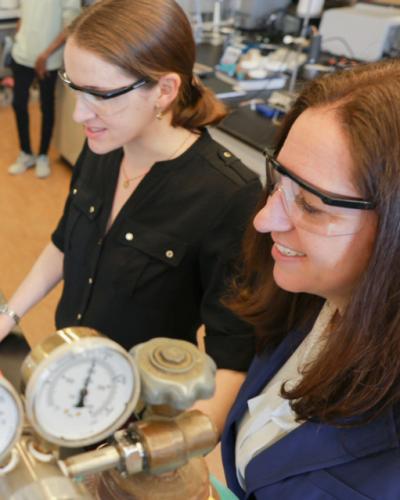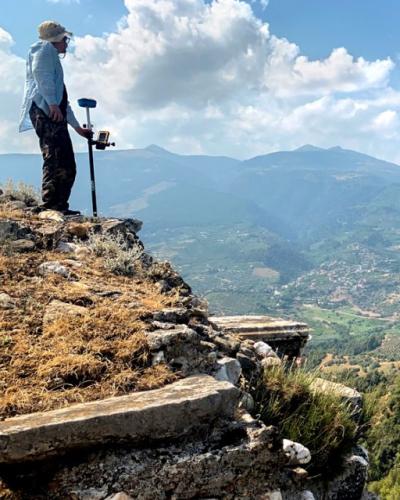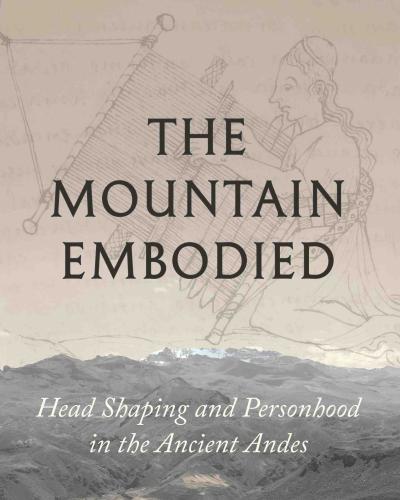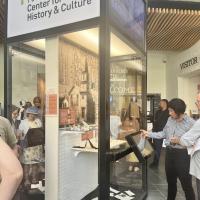Over the last several months, a certain bird – believed to be a sacred ibis – has been drawing a lot of attention, and covering a lot of ground, from the College of Arts and Sciences to the College of Veterinary Medicine, College of Engineering and, later, the Lab of Ornithology.
Not bad for an animal that has been dead and mummified for more than 1,500 years.
The so-called “mummy bird” has had help getting around. Carol Anne Barsody, a master’s student in archaeology, has been trying to learn everything she can about the artifact, which is part of the Anthropology Collections in the College of Arts and Sciences, by consulting an array of researchers from across the university.
“One of the things I love about this project is that it incorporates expertise from across Cornell, all working together on a common goal,” Barsody said. “Where else but Cornell can you speak with a curator of vertebrates about a skeleton, and then call the vet school and have it X-rayed? There are so many different resources that students can utilize. And interdisciplinary projects make for stronger research.”
What began as a passion project, and grew into an independent study and then a proposed master’s thesis, has become a cross-campus fascination that encompasses everything from ancient burial rituals to the lost history of donated artifacts, the totemic power of animals, the ways museums can better engage the public, and even Egyptian beer.
The hawk that wasn’t
Like many things that existed before the invention of the internet, television, the printing press and the Bible, the mummy bird’s exact provenance is difficult to determine. Its physical appearance – a tear-shaped swaddle of linen that resembles a stretched potato, barely larger than a football – reveals very little, and no record exists of the mummy’s arrival at the university, probably a century or more ago. Since then, it has moved among various university collections, stored inside a box mislabeled “hawk mummy.”
“As tempted as I might be, I try to let things sit and wait for students to come along who want to work with them,” said Frederic Gleach, senior lecturer and curator of the Anthropology Collections. “The whole point of it is a teaching exercise.”
Ever since the late 1800s, mummies of different shapes and sizes and species have found their way to Cornell. The most noteworthy was a human mummy named Penpi, who had been a scribe of Thebes in the Third Intermediate Period (828-625 BC), and who made national headlines when he was shipped to Cornell in 1884 by George Potwin Pomeroy, the U.S. ambassador in Cairo.
Barsody thought the mummy bird might have been part of that freight, which would indicate that it, too, probably originated at the Necropolis of Thebes.
“That would make him older than the first Olympics at Greece on record,” Barsody said.
However, as Barsody did more research, she found the Board of Trustees minutes from 1884, which referenced the arrival of Penpi but had no mention of any other Egyptian artifacts. She now suspects the mummy bird may have been part of a cache from Saqqara that was donated in 1930 by an alumnus, John Randolph, Class of 1903, although after that, the trail goes cold.
“There’s no putting it back together again”
Barsody herself found a unique route to the project. She first came to the university not as a student, but as an employee, with a background in mathematics, working for the Center for Technology Licensing. Then she entered the Employee Degree Program and received full tuition to pursue her master’s degree in archaeology.
Her primary research interest is the ways technology can be integrated within museum exhibitions, and how that might change museum collecting practices, access to collections and help with repatriation efforts. The mummy bird made for an effective case study. So Barsody set out to find collaborators who could use 21st-century technology to help her peek under the mummy’s wrappings without disturbing the integrity of the artifact – an archaeological courtesy that was not always extended to past mummies. Just ask Penpi, who, over the years, was unwrapped and disarticulated before being finally put into secure storage while his sarcophagus remains on display.
“Much of archaeology is destructive,” Gleach said. “Once you’ve excavated something, there’s no unexcavating it. Once you’ve unwrapped a mummy, there’s no putting it back together again.”
But before she could do anything, Barsody had to confirm that she actually had a real mummy to study.
“A mummified creature would be interred with a person either as an offering or as a companion into the afterlife,” Gleach said. “In later periods, there was a sort of inflationary process. It wasn’t enough to have one with you, you had to have as many as you could afford. And so we sometimes see fake mummies.”
The Anthropology Collections has one such mummy, that, while shaped like a miniature human, only contains sticks, rolls of linen fabric, and a few bones.
In November, Barsody and Gleach brought their mummy to the College of Veterinary Medicine (CVM), where an imaging technician at the Cornell University Hospital for Animals conducted radiographs and a CT scan that confirmed their bundle did in fact contain a bird. Not only that: The CT scan showed that some of the bird’s soft tissue and feathers were still intact and its leg was fractured before it was mummified. Time and international transit had also apparently taken their toll on the bird, as its beak appears to have been posthumously broken.
Mummification was not the gentlest of processes, either. The Egyptians mummified everything from cats and dogs to snakes and baboons, even crocodiles. Animals that were not already dead from natural causes were killed. They were often eviscerated, and their bodies were dipped into a boiling vat of resin or pitch, which typically initiated a reaction that burned their bones to dust. This, however, seems not to have been the case for the mummy bird, since the CT scan showed skeletal remains.
A real-life puzzle
Hoping to learn more about their bird’s biological and physiological characteristics, Barsody and Gleach took the mummy to Vanya Rohwer, the curator of the birds and mammals at the Cornell Museum of Vertebrates, housed at the Lab of Ornithology.
After reviewing the scans and consulting a database, Rohwer identified the bird as a male sacred ibis – a gangly, long-legged bird, similar to the stork and heron, with a black head and black and white wings – on account of its downward sloping bill. This wasn’t a total surprise, Barsody said, since ibises were commonly mummified due to their association with death and Thoth, the god of wisdom and magic. Ibises were so popular, they were sometimes bred en masse, similar to the puppy mills of today, for the sole purpose of being sold as votives.
But how exactly this lanky ibis was folded into its current form was difficult to discern from the CT scan’s cross-sectional images. So the researchers went through the museum’s collections of study skins and skeletons and, fitting the pieces together, they reconstructed the bird’s shape. By doing so, they determined that the ibis’s head had been twisted around and bent all the way back against its body, and its ribcage and sternum appeared to have been removed, which was not a common practice.
Rohwer weighed the mummy, which came in at 942 grams, roughly the same as a quart of milk.
As best they can tell, the bird is somewhere on the order of 1,500 to 2,000 years old.
“It’s fun to piece these things together,” Rohwer said. “It’s a real-life puzzle.”
The most significant piece of that puzzle may turn out to be the soft tissue the CT scan revealed. Barsody is now back at CVM, consulting with Dr. Eric Ledbetter, professor and section chief of ophthalmology, about the prospect of extracting genetic material through endoscopic microsurgery. If the bird’s DNA matches any other samples from a database of mummified sacred ibises, Barsody should be able to determine the temple where it was buried, and thus the age and the region in which it lived.
“The key here is not to destroy the integrity of the object,” Barsody said. “Research is great, but so is preserving history and objects for future generations.”
Back to life
Even with all the legwork that Barsody has done, the emailing, the meetings, the research, the next phase of the project is even more ambitious.
“I want to bring the bird back to life,” she said.
Barsody is working with electrical and computer engineering student Jack Defay ’22 to scan the mummy with open-source technology and smart phones in order to build a 3D model of the bird – a low-cost method of artifact digitization that could be easily replicated by other institutions, thereby increasing access for their collections. The Herbert F. Johnson Museum of Art recently started working with Defay on adopting this technique for digitizing its own artifacts.
The mummy bird, its 3D model and a hologram version will all be included in a multisensory exhibition that Barsody is planning to hold in October.
“The goal is to gauge the public’s readiness for exhibitions without the artifacts,” said Barsody, who currently works at the Johnson Museum of Art. “That gets into bigger questions about repatriation, institutional collecting practices, access and education in this post-COVID world, where you might not be able to actually get to a museum. I’m really interested in the multisensory aspects. Using not just your sight, but also feel, smell, hearing.”
Those senses might even include taste. Barsody is in talks with the Big Red Brewing graduate student group about recreating an ancient traditional Egyptian beer – in the same spirit as their recent “Gorges Libe-ation” red ale – in partnership with Lucky Hare Brewery.
Barsody is also creating educational packets about the mummy bird for K-12 programs, and she’s surveying museum professionals and the general public about integrating technology to increase museum engagement and accessibility. As part of her educational outreach, she will also be launching a website, www.birdmummy.com.
Barsody admits that her big bird hunt consumes much of her time now, to the extent that her fiancé gave her a model ibis head for Valentine’s Day.
All the while, she continues to dig through university archives and historical records to learn as much as she can about the mummy and what it meant to a culture that thought so highly of this bird, they preserved it forever.
“Not only was this once a living creature that people of the day may have enjoyed watching stroll through the water. It also was, and is, something sacred, something religious,” Barsody said. “Now it has this whole entire life of being studied, and respected, as a small representative of the amazing culture from which it originated. It’s had multiple lives. I look at what I’m doing as another form of extending its incredible life.”






